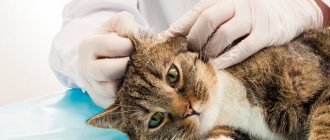Almost always, bald patches above a cat's eyes indicate the development of an allergic reaction, parasite activity, or a bacterial or fungal infection. Rarely, this symptom is a cosmetic defect or the result of a recently healed wound.
Hair loss above the eyebrows is especially noticeable in British, Persian, Maine Coon and exotic cats. These breeds often suffer from pathologies associated with the organs of vision. Baldness is easily explained by increased lacrimation and severe itching, which causes the pet to scratch itself until it bleeds.
Causes of baldness
If your cat's ears are going bald, you need to determine the cause. All sorts of factors can cause hair loss.
Allergic reactions
Animal shampoos, medications, and dry food can cause allergies in a cat. The manifestation often appears in the form of ulcers on the skin, coughing, and bald spots on the cat’s ears. Washing powder, air freshener, which stands next to the cat litter box, is a strong allergen for the sensitive body of the cat.
Hair loss in cats is a common problem.
Attention ! Smoked, salty foods can cause an allergic reaction. It is necessary to go to a veterinary clinic and undergo blood tests and allergy tests.
If a skin irritant is detected, the animal’s interaction with it must be excluded. Change food, limit your pet’s contact with chemicals in the bathroom.
Skin infections and parasites
Often, a cat's ears become bald due to the influence of parasites living on the skin. It could be a subcutaneous tick, fleas, or lichen. Parasites that are not detected in time will lead to skin irritation and hair loss.
If your cat's ears become bald, you should immediately make an appointment with your veterinarian. Ear mites and scabies cause discomfort for the animal. The cat will constantly itch and may cause an infection in the wound.
Psychogenic influence
A stressful state can cause an animal to lose a significant amount of hair. The pet becomes restless, tries to hide or behaves aggressively. Due to nervousness, the animal actively licks itself. Irritated skin becomes covered with ulcers, hair falls out, and bald patches may appear. The cat's ears are also going bald.
If your cat is constantly nervous, it can cause baldness.
Hormonal disorders
Impaired function of the thyroid gland and pancreas is accompanied by deterioration of metabolism. If your cat has a bald spot behind the ear, you need to check the animal's hormones.
Attention ! Hair loss may be associated with impaired liver function and decreased levels of liver enzymes. Failure of the liver leads to intoxication of the body, which manifests itself in the form of alopecia.
Heredity
Ears can go bald not only due to malfunctions in the body. Sometimes alopecia is a normal feature inherited by the kitten from its parents. These animals are born with fur. Then they go completely bald, and after a certain time they grow back. First of all, hair falls out around the eyes, on the eyebrows, on the paws, and under the arms. This type of baldness is called hypotrichosis and has no cure.
Causes of the disease
Alopecia (baldness) in a cat can have a different nature. In most cases, the appearance of characteristic bald patches near the ears and above the eyes is associated with a food allergy affecting the animal. Typical allergens are the following:
- vegetable and animal proteins;
- cereals;
- mutton.
In addition to the allergic factor, a psychogenic factor contributes to the appearance of bald spots in cats. This type of disease is symptomatic of the formation of foci of alopecia on the following parts of the animal’s body:
- hips;
- inner surface of paws;
- stomach.
If the veterinarian confirms the psychogenic nature of the appearance of bald patches, the pet owner should eliminate the cause that caused the stress, and then resort to the use of sedatives intended for animals. If baldness is accompanied by an inflammatory process or dermatitis, it is necessary to treat them as well.
The appearance of bald patches near the ears and above the eyes may indicate that the cat has a hormonal disorder. Symptoms of this disease can also appear on the following parts of the body:
- on the stomach;
- in the area of the hind limbs;
- on the chest and abdominal walls;
- in the anogenital part of the body;
- in the armpits of a pet.
So-called “endocrine alopecia” in cats may also indicate the following severe systemic diseases:
- hypothyroidism (thyroid dysfunction);
- Cushing's syndrome (hyperfunction of the adrenal cortex);
- post-castration syndrome - with this pathology, the animal’s neck becomes bald, and a kind of collar is formed;
- acromegaly;
- diabetes.
The list of causes of baldness in cats would be incomplete without mentioning a disease such as dermatomycosis. A similar disease is a progressive alopecia, the areas of localization above the eyes, near the ears and on other parts of the animal’s body have a round or ring-shaped shape.
The skin in the affected areas is characterized by increased dryness, but the pet is not bothered by itching. Ringworm occurs due to a fungal infection that affects the hair or epidermis of the animal. Treatment of the disease, accordingly, is carried out with special antimycotic drugs.
Rare causes of bald patches in the ears and above the eyes in cats include the following:
- neoplasms of benign and malignant origin;
- allergic reaction to certain medications;
- hereditary factor;
- various parasitic diseases (lichen, mites, cat scabies).
Baldness in kittens
Minor bald patches on a kitten's ears can be a manifestation of serious illnesses that need to be treated. Over time, the disease becomes chronic, sometimes leading to the death of the cat. That is why, if a bald spot appears on the inside or outside of the ear, you should immediately seek medical help at a clinic.
Hair loss can occur due to a lack of vitamins and poor nutrition. A hairless kitten is most susceptible to skin infections due to the presence of exposed areas of the body.
Often, scanty hair can be caused by poor nutrition of a nursing cat. Breast milk does not supply enough vitamins, and the baby begins to go bald.
Recommended! To prevent diseases, the kitten should be shown to a veterinarian. He will examine and vaccinate the animal.
Diagnostic methods
If your cat's ears are going bald, there is brown discharge from the ears and redness of the skin, then you should contact a veterinarian for help. The specialist will examine the area with lost hair and become familiar with the symptoms that are bothering the pet. If it is not possible to visually determine the cause and severity of the disease due to which the bald spot appeared, then additional diagnostic procedures are prescribed. To make a diagnosis, the following manipulations may be required:
- laboratory testing of blood and urine;
- bacterial culture of urine;
- scraping from the damaged area with further microscopy;
- ultrasound diagnostics of internal organs if there is a suspicion of a violation of their function;
- allergic reaction test.
Return to contents
Prevention
To prevent a cat from developing a bald spot on its head, there are a number of preventive measures. The pet is periodically examined, regularly given prophylaxis against worms, and a balanced diet is selected. The animal is promptly vaccinated against diseases. Your pet should not be walked near places where stray cats accumulate.
Attention! Long-haired cats need to be brushed frequently. It is necessary to monitor the cleanliness of the fur of all cat species.
Diet
You need to put your cat on a diet diet. Do not feed your animal dry food, as industrial food contains a large amount of preservatives and artificial flavors.
It is recommended to feed your pet boiled dietary meat - veal, rabbit, turkey. You can add seasonal vegetables and fruits to your diet.
If a pregnant cat has a bald spot on her ear, the reason is a lack of vitamins, which she does not receive from food. Such pets need special nutrition rich in nutrients.
Important! It is forbidden to feed the cat sweets, smoked meats, and salty foods. Such products are strong allergens.
Protect from stress
A nervous situation in the house, the appearance of children or other animals - all these factors adversely affect the cat’s psyche and can cause bald spots in a cat.
If a cat reacts painfully to changes in his life schedule, the arrival of guests, or a change of environment, you need to try to protect him from stress. You can treat your pet’s nerve pain with sedatives, which should be prescribed by a veterinarian.
Regular inspection
To detect baldness at an early stage and prevent further hair loss, you need to constantly examine your pet. Once every six months the cat is taken to a veterinarian for examination. They take tests and conduct an external examination. If signs of illness or bald patches appear on the animal, treatment is carried out.
Abrasions and scratches that your pet received in the game must be treated with a disinfectant solution.
Examining your cat at a veterinary clinic will help identify the disease in time.
Regular visits to the veterinary clinic, proper nutrition, and grooming are the conditions under which the animal will be healthy. This is why you need to pay attention to the cat. And if a cat’s ears become bald, he is urgently taken to a doctor for examination.
If a cat's ears become bald without obvious reasons, then special attention should be paid to this symptom, as there is a risk of contracting lichen, which can be transmitted to other animals and humans. Minor hair loss in the ear area can be caused by a number of other diseases that are not dangerous to humans, but require treatment for the pet itself.
What to do if your cat's ears are going bald
A large list of reasons that can provoke baldness of an animal’s skin in the ear area excludes the possibility of independently determining the only correct one. Therefore, it is better to consult a doctor , because... Only a qualified and experienced veterinarian will be able to resolve doubts at first glance and say what exactly happened to the pet. There is no point in being scared in advance - the owner may simply have to exclude chicken or another product from the cat’s diet, or it may require long-term and expensive treatment with antibiotics.
Harmless reasons
Cats with a genetic predisposition to dermatitis may periodically lose hair on their ears and other parts of the body. This is not dangerous until severe itching occurs, forcing the animal to scratch itself until it bleeds. Such a reaction can be provoked by incorrectly selected food or a single product.
Injury. If there are other animals in the house with whom the cat plays/quarrels, then there is a risk of injury, due to which pieces of hair may be torn out. Very often, in such places, hair stops growing until the end of life. If there are no deep wounds, then nothing needs to be done. Otherwise, you can treat the affected area with a chlorhexidine solution.
Bald patches in cats: near the ears, causes and methods of eliminating the problem
The so-called periaucular alopecia (the appearance of characteristic bald patches near the ears) is a common phenomenon in many cats.
Other signs of skin pathologies are often absent. Most often, symptoms of alopecia appear in cats with short hair; itching is completely absent. Alopecia, as a rule, is heterogeneous in nature, covers the entire ear area, and can spread to other areas of the animal’s skin. We will discuss further why this pathology occurs.
Cat's ears are bald photo
What is the normal coat of hair on a cat's ears and above the eyes?
Before diagnosing your pet yourself, it is worth clarifying what the hair on the face of a healthy animal should look like. Are small bald spots under the eyes and ears of an animal a sign that it is going bald?
According to the observations of felinologists, the presence of small “gaps” in the fur on a cat’s temples is an absolute norm. If you look closely at the pet, it turns out that the bare “spots” found on its face are bald patches in the usual sense of the word, but just areas covered with lighter, shorter and sparse (compared to the rest of the head) hairs.
It is easy to make sure that small bald spots on the temples are a physical feature characteristic of a biological species, and not a sign of a disease. Suffice it to remember that hairless spots on the pet’s face were always present - both when he was a kitten and when he became an adult.
As your pet ages, the area of bald spots on his head may increase, and the density of hair in problem areas, on the contrary, may decrease. However, if the cat is healthy, the process of thinning the coat occurs gradually, without affecting the well-being of the animal and without causing anxiety in its owners.
Possible diseases
There are many diseases of a fungal and infectious nature that can cause baldness in one or both ears of a cat:
- Otitis. An inflammatory process occurring in the ear canal. Always has a provoking factor. Most often these are parasites or dermatitis. It manifests itself in the form of discharge from the ears, tilting the head to one side and severe itching, which forces the animal to scratch its ears until it bleeds. Large bald patches and open wounds appear in these places. The diagnosis is made based on visual examination and otoscopy, which allows to exclude damage to the ear canal and eardrum. In severe cases, MRI and CT may be needed. Treatment is long-term, aimed at eliminating the cause of otitis media. Rinsing the ear canal with warm saline solution is indicated.
- Allergy. Can be food or contact. The most common cause of ear hair loss in cats. Food allergies can cause otitis media or occur on their own with periodic outbreaks of itching and redness in different parts of the body. It is necessary to find and eliminate the source of the allergen, otherwise there is a risk of developing a chronic course. In cases of swelling and large red spots, the pet is prescribed antihistamines.
- Ear mite. An extremely unpleasant phenomenon that can lead to excruciating pain for your pet. It can manifest itself in the form of baldness of the ears (due to constant scratching), the appearance of black/brown discharge inside and an unpleasant odor. The animal does not allow itself to be stroked on the head. Diagnosis includes visual examination, examination of scrapings from lesions to confirm the presence of a mite, and cytology to exclude a secondary bacterial infection. For treatment, you can use the drugs Frontline and Stronghold. The therapeutic effect occurs after 2-4 weeks. Can be used even during pregnancy. Also, special solutions (“8 in 1” or Otifri) are used to rinse the auricle.
- Fungal infections. Namely, lichen, which often occurs even in cats that have never been outside. The thing is that some types of mushrooms can survive in the environment for more than a year. Characteristic symptoms include baldness of a specific or several areas of the skin (ears, abdomen, back, and less commonly, limbs). Weeping and redness appear at the site of hair loss. There is also severe itching. There is a high risk of infecting other animals and people living in the house. Confirming the diagnosis and determining the culture of the fungus can only be done through microscopic examination and bacterial culture. And only on the basis of the obtained tests are antifungal drugs selected. According to leading veterinarians from around the world, vaccination is ineffective in either treating or preventing lichen. Therefore, based on tests and the clinical picture, a special shampoo, tablets for oral administration and ointments for external treatment are selected. The therapeutic effect can occur after 2-3 weeks of systemic administration of the drugs. Great importance is also given to disinfecting all surfaces where fungal spores may be present. Bed linen is boiled, carpets and rugs are treated with solutions of lime and chlorhexidine.
Other causes of the disease
In rare cases, the factor that causes the appearance of bald patches is the following serious illnesses:
- Acromegaly;
- Problems with the thyroid gland (hypothyroidism);
- Diabetes;
- The period after castration;
- Hyperfunction of the adrenal cortex (Cushing's syndrome);
Other pathologies can also provoke the formation of bald spots. Some cats develop skin diseases due to allergies to medications. The presence of parasitic diseases also sometimes leads to alopecia.
In this case, it will be easy to notice the presence of parasites, since the influence of mites, lichen and cat scabies will immediately be reflected in the condition of the coat. In rare cases, bald patches appear in the presence of benign or malignant tumors. Hereditary factor is another reason for cat baldness.
Causes of baldness
First, you need to figure out why your cat's ears are going bald. In fact, this symptom can be triggered by anything, from allergies to stress, and only a veterinarian can determine the real cause.
However, there are several common factors:
- Allergic reactions;
- Skin infections and parasites;
- Psychogenic influence;
- Hormonal disorders;
- Heredity.
Allergy
Allergic reactions can occur due to toxic substances and various environmental factors; A new food or medication can also provoke an allergy, as a result of which the hair on the cat’s ears falls out, the shells themselves turn red, become covered with a rash, and begin to itch unbearably, which is why the animal scratches its ears too much. Treatment is carried out in only one way - isolating the allergen from the cat's diet or environment and using medications prescribed by the veterinarian.
Skin infections and parasites
- Otodectosis or scabies. Otodectosis occurs due to infection with ear mites, which can cause purulent otitis media. The ears become red and itchy, and the itching can spread down to the neck, causing the cat to try to relieve it by scratching itself excessively. This is what causes baldness.
- Ringworm and other fungal infections. Fungi are very dangerous, so they try to exclude lichen as the cause of baldness in the first place. Emergency veterinary assistance is especially necessary if ear hair loss is accompanied by redness and rash.
- Viruses. Viral infections that cause hair loss in a cat's ears can affect any organ, from respiratory diseases to eye lesions. Only a specialist will help determine what exactly the animal is sick with and choose the right medications; self-medication can only worsen the cat’s condition.
Why is there a problem?
In veterinary medicine, hair loss in the area of the ears and other parts of the cat’s body is called alopecia. The following factors can influence the occurrence of bald spots above the eyes:
- Allergic reaction. The source of allergies are toxic substances, dry food and some food products, medications and more. When your cat is exposed to allergens, his bald spots increase and severe itching and irritation occur.
- Otodectosis or scabies. The disease, which causes hair loss on the head and in the ears, is caused by the activity of ear mites. If not treated in a timely manner, the disease leads to otitis media.
- Ringworm and other fungal infections. The fungus poses a health hazard to cats, especially kittens, and can lead to baldness. It is worth contacting a veterinarian as soon as your pet’s fur begins to fall out and redness occurs.
- Viral diseases. Against the background of the disease, symmetrical alopecia and other unpleasant symptoms may occur. Bald spots due to viral diseases are visible not only in the ears, but also in the area of the hind legs and other parts of the body.
- Hormonal imbalances. A pregnant cat faces similar problems, and baldness can also occur due to hyper- or hypothyroidism.
- Hereditary factor. Baldness can be caused by gene mutations that are inherited.
Veterinarians do not recommend exposing pets to severe stress, since against this background the animal may refuse to eat and become restless, including the cat becoming bald in the ear area.
Causes of baldness in kittens
If a young representative of the cat family has bald ears, this does not always indicate a pathological process. Owners should pay attention to the kitten's nutrition. It is not recommended to suddenly change one food to another or try to somehow diversify the animal’s diet. If the problem lies in an unbalanced diet, then it is worth giving the animal vitamins. Baldness on the hind legs, ears and other parts of the body can also be a consequence of insufficient function of the immune system.
Baldness in kittens
Small cats are very sensitive creatures, and owners sometimes notice that the kitten has hair coming out, starting from the tips of its ears. But this does not always indicate illness; experts advise first carefully monitoring the animal’s diet. It is not uncommon that due to a varied diet filled with food that is not entirely suitable for animals, the body begins to react in this way. Alternately eliminating certain foods in combination with vitamins will help the kitten regain fluffy hair on its ears.
How to distinguish normality from pathology?
Baldness of skin areas is not always caused by pathological reasons. In some cases, hair loss occurs in cats that have recently given birth to kittens. The problem arises due to an unbalanced diet. A nursing mother needs increased nutrition and vitamin intake.
In animals of smooth-haired breeds, bald spots can occur as a result of regular licking of the fur, due to genetic predisposition.
Hair loss may indicate nervous strain that has arisen in the cat as a result of moving or having a new pet. Such situations are stressful for the pet; treatment is by taking sedatives.
Vitamin deficiency can be another reason for hair loss.
Treatment of bald ears in cats
Only a veterinarian can provide full assistance to a cat in such a situation; independent treatment is not the best option here. Only a doctor can determine the disease and formulate a treatment plan.
If your cat's ears are going bald due to allergies, you will have to change the environment a little. Perhaps some flowers will disappear from the apartment interior, and the hostess will have to part with her favorite perfume. To avoid a repeat reaction, it is better for the animal to eat hypoallergenic food.
Bacterial and viral infections are treated with a special set of drugs, a new diet and the introduction of vitamin complexes into the diet.
The effects of emotional turmoil may need to be treated with mood modifier pills. Of course, this is not the best outcome, but the cat owner needs to prepare in advance for such a verdict.
How to treat alopecia in cats
The nature of the treatment depends on the cause that provoked the appearance of local bald patches. If the disease is allergic, it is necessary to isolate the animal from exposure to allergens. “The veterinarian should prescribe immunostimulants and antiallergic drugs to the cat.” In addition, the animal must adhere to a special hypoallergenic diet.
If alopecia is caused by parasites, the animal is recommended to use special sprays, gels, and ointments that have antiparasitic properties. In addition, the cat should additionally take vitamin complexes to stimulate immune function.
Abscess and pyoderma, which also provoke alopecia, are treated by treating the skin with systemic and external antibiotics, as well as antiseptics.
Taking hormonal medications is indicated for endocrine alopecia, but if the disease is of a psychogenic nature, the cat is prescribed sedatives.
Prevention
You can avoid hair loss in your cat's ears with the following tips::
- Diet. The cat's diet should be balanced, varied and appropriate to its health.
- Self-treatment. In some cases, owners resort to this method, confident that they have made the correct diagnosis. It's better not to take risks.
- Stress. It is necessary to protect the cat as much as possible from emotional turmoil, especially if it is prone to long experiences.
- Regular inspection. It is necessary to visit the veterinarian every few months to prevent the disease or to prevent it from spreading throughout the animal's body.
There are two types of hosts. Some do not pay attention to any symptoms, including those cases when the cat's ears begin to go bald. Others, on the contrary, examine their pets four times a day and, at the first abnormal formation, run to the veterinarian screaming that their kitten is dying. Which one is right? Neither one nor the other. You need to find a middle ground in caring for your animal.
How to protect your cat from baldness
It's actually quite simple, just follow these tips:
- Make your pet's diet balanced, rich in essential microelements and vitamins.
- Do not self-medicate; all medications for animals should only be given with the permission of a veterinarian.
- Avoid plants that pose a potential threat in your home
- Protect your animal from stressful situations
- Keep your cat up to date on vaccinations and see your veterinarian regularly. This will prevent baldness, and if there is already a lesion on the ears, it is possible to prevent it from spreading.











